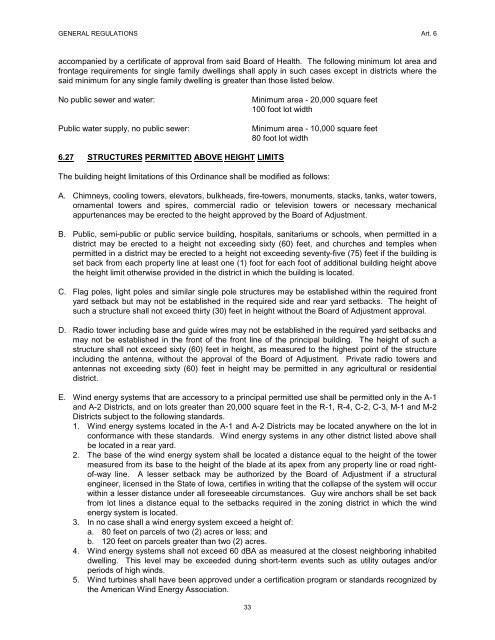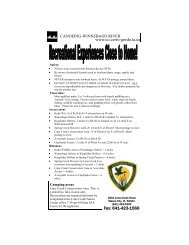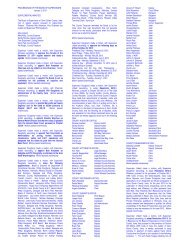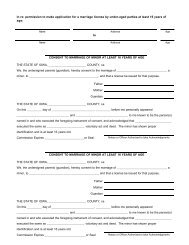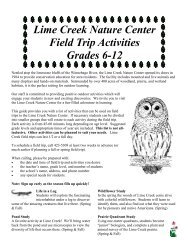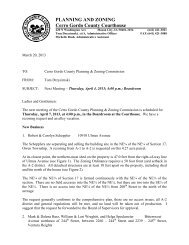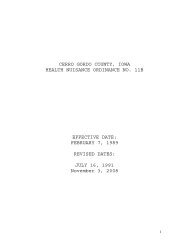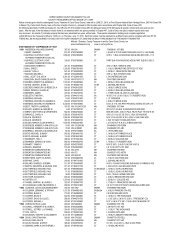Zoning Ordinance (pdf) - Cerro Gordo County online
Zoning Ordinance (pdf) - Cerro Gordo County online
Zoning Ordinance (pdf) - Cerro Gordo County online
Create successful ePaper yourself
Turn your PDF publications into a flip-book with our unique Google optimized e-Paper software.
GENERAL REGULATIONS Art. 6<br />
accompanied by a certificate of approval from said Board of Health. The following minimum lot area and<br />
frontage requirements for single family dwellings shall apply in such cases except in districts where the<br />
said minimum for any single family dwelling is greater than those listed below.<br />
No public sewer and water:<br />
Public water supply, no public sewer:<br />
Minimum area - 20,000 square feet<br />
100 foot lot width<br />
Minimum area - 10,000 square feet<br />
80 foot lot width<br />
6.27 STRUCTURES PERMITTED ABOVE HEIGHT LIMITS<br />
The building height limitations of this <strong>Ordinance</strong> shall be modified as follows:<br />
A. Chimneys, cooling towers, elevators, bulkheads, fire-towers, monuments, stacks, tanks, water towers,<br />
ornamental towers and spires, commercial radio or television towers or necessary mechanical<br />
appurtenances may be erected to the height approved by the Board of Adjustment.<br />
B. Public, semi-public or public service building, hospitals, sanitariums or schools, when permitted in a<br />
district may be erected to a height not exceeding sixty (60) feet, and churches and temples when<br />
permitted in a district may be erected to a height not exceeding seventy-five (75) feet if the building is<br />
set back from each property line at least one (1) foot for each foot of additional building height above<br />
the height limit otherwise provided in the district in which the building is located.<br />
C. Flag poles, light poles and similar single pole structures may be established within the required front<br />
yard setback but may not be established in the required side and rear yard setbacks. The height of<br />
such a structure shall not exceed thirty (30) feet in height without the Board of Adjustment approval.<br />
D. Radio tower including base and guide wires may not be established in the required yard setbacks and<br />
may not be established in the front of the front line of the principal building. The height of such a<br />
structure shall not exceed sixty (60) feet in height, as measured to the highest point of the structure<br />
including the antenna, without the approval of the Board of Adjustment. Private radio towers and<br />
antennas not exceeding sixty (60) feet in height may be permitted in any agricultural or residential<br />
district.<br />
E. Wind energy systems that are accessory to a principal permitted use shall be permitted only in the A-1<br />
and A-2 Districts, and on lots greater than 20,000 square feet in the R-1, R-4, C-2, C-3, M-1 and M-2<br />
Districts subject to the following standards.<br />
1. Wind energy systems located in the A-1 and A-2 Districts may be located anywhere on the lot in<br />
conformance with these standards. Wind energy systems in any other district listed above shall<br />
be located in a rear yard.<br />
2. The base of the wind energy system shall be located a distance equal to the height of the tower<br />
measured from its base to the height of the blade at its apex from any property line or road rightof-way<br />
line. A lesser setback may be authorized by the Board of Adjustment if a structural<br />
engineer, licensed in the State of Iowa, certifies in writing that the collapse of the system will occur<br />
within a lesser distance under all foreseeable circumstances. Guy wire anchors shall be set back<br />
from lot lines a distance equal to the setbacks required in the zoning district in which the wind<br />
energy system is located.<br />
3. In no case shall a wind energy system exceed a height of:<br />
a. 80 feet on parcels of two (2) acres or less; and<br />
b. 120 feet on parcels greater than two (2) acres.<br />
4. Wind energy systems shall not exceed 60 dBA as measured at the closest neighboring inhabited<br />
dwelling. This level may be exceeded during short-term events such as utility outages and/or<br />
periods of high winds.<br />
5. Wind turbines shall have been approved under a certification program or standards recognized by<br />
the American Wind Energy Association.<br />
33


